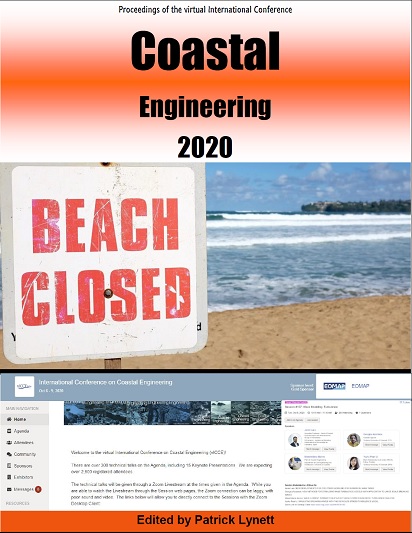Abstract
The Building with Nature (BwN) approach developed by Ecoshape suggests that nature-based solutions can be sustainable and cost-effective alternatives for traditional engineering solutions. Widening the solution space by studying and understanding the physical and ecological system in the early stages of port planning and design is more likely to result in sustainable ports with opportunities for multi-functionality and respect for nature. This paper applies the BwN philosophy to a case study, i.e., the ongoing port development in Kuala Tanjung in Indonesia and examines the technical and financial feasibility of a nature-based concept, i.e., a mangrove breakwater instead of a traditional 'hard' breakwater. Mangroves can realize significant wave attenuation, and at the same time, they are productive eco-systems that can result in long-term benefits through multifunctional land use. A berm built of dredged material with a mild slope which 'grows' naturally by accretion behind permeable dams can create the right conditions for mangrove trees to grow. This mangrove protection can develop into a sustainable barrier which grows with the (relative) sea level rise by trapping sediments. A preliminary design was made on the basis of information available in literature. A rough cost comparison considering only the supply and placing of fill material showed that mangrove breakwater is about 25percent more expensive than a hard breakwater for the case under study. In view of the numerous port projects being planned in Indonesia, the technical and financial feasibility of mangrove breakwaters that can also enhance nature create added value for the surroundings is a promising finding.Recorded Presentation from the vICCE (YouTube Link): https://youtu.be/Rr8P8G1GjgM
References
CBD (Convention on Biological Diversity). 2011. “X/2.Strategic Plan for Biodiversity 2011-2020”. Accessed 23 May, 2018. https://www.cbd.int/decision/cop/?id=12268.
EcoShape. 2018. “Building with Nature Guidelines.” Accessed 23 May, 2018. https://buildingwithnatureguidelines.org.
EcoShape. 2018a. “Building with Nature Indonesia”. Accessed 23 May, 2018. https://www.ecoshape.org/en/projects/building-with-nature-indonesia/.
Laboyrie, P., Van Koningsveld, M., Aarninkhof, S.G.J., Van Parys, M., Lee, M., Jensen, A., Csiti, A. and Kolman, R. 2018. Dredging for Sustainable Infrastructure Development, CEDA / IADC. The Hague, The Netherlands.
PIANC (World Association for Waterborne Transport Infrastructure). 2014. Report 150: Sustainable Ports - A Guide for Port Authorities. Brussel: PIANC.
UN (United Nations). 2018. “Sustainable Development Goals”. Accessed 23 May, 2018. https://www.un.org/sustainabledevelopment/sustainable-development-goals/.
van der Hoek, A.P.L. 2018. “Applying the Building with Nature philosophy for sustainable port development.” MSc thesis, Delft University of Technology, the Netherlands. https://repository.tudelft.nl/islandora/object/uuid%3A7754d39f-b744-4421-b07b-bed6c58a62cf.
Wetlands International. 2018. “Technical Guidelines #3 Permeable Structures – Building with Nature to restore eroding tropical muddy coasts.” Accessed 23 May, 2018. https://www.wetlands.org/publications/technical-guidelines-permeable-structures/
Winterwerp, J.C., Borst, W.G., and De Vries, M.B. 2005. Pilot study on the erosion and rehabilitation of a mangrove mud coast. Journal of Coastal Research 21(2), 223–230.

